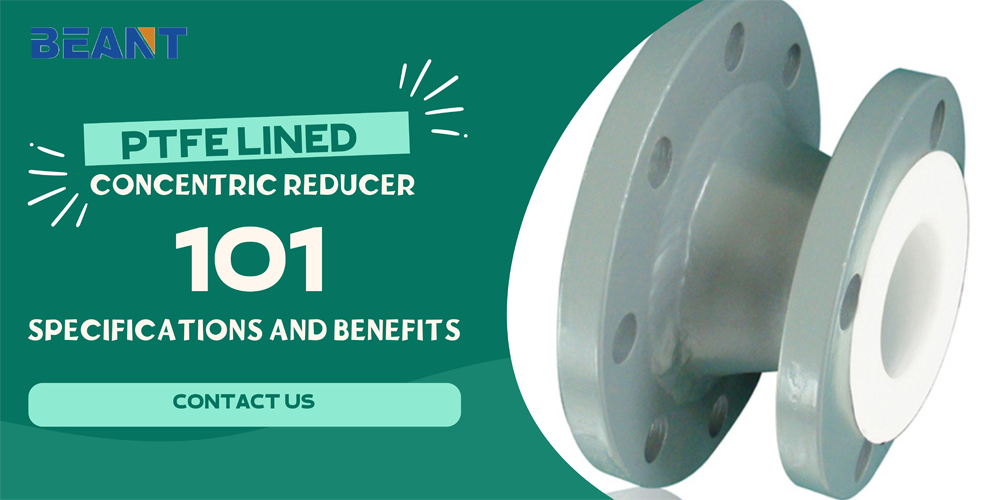
In the realm of industrial piping systems, the efficiency and integrity of fluid transfer are paramount. Among the various innovations designed to enhance this process, PTFE Lined Concentric Reducers stand out due to their robustness and versatile functionality. These reducers play a crucial role in connecting pipes of different diameters while maintaining the lining continuity and ensuring a smooth flow of corrosive or high-purity fluids.
PTFE (Polytetrafluoroethylene) lined concentric reducers are engineered to merge the advantages of PTFE linings with the structural strength of metal. The PTFE lining provides unmatched chemical resistance, reducing the risk of corrosion and leakage, especially in aggressive environments like chemical processing plants, pharmaceuticals, and food and beverage production.
These reducers are typically manufactured from durable materials such as Ductile Iron, Cast Steel, and Stainless Steel. They are lined with high-quality PTFE, PFA (Perfluoroalkoxy polymer), FEP (Fluorinated ethylene propylene), or other plastics like PVDF (Polyvinylidene fluoride) and PP (Polypropylene), depending on the specific application requirements. This combination ensures that the reducers can withstand both the mechanical stresses of industrial use and the aggressive nature of processed fluids.
The design and construction of PTFE lined concentric reducers adhere to stringent standards, including ASME B 16.5 class 150 and DIN dimensions, to ensure compatibility and ease of integration into existing piping systems. The use of flanged end connections enhances their adaptability, allowing for secure and leak-free installations.
PTFE lined concentric reducers are not just any piping component; they are a specialized solution designed to ensure optimal flow dynamics and chemical resistance in various industrial environments. The choice of materials and the precise design are central to their functionality and durability.
1.Ductile Iron:
Ductile iron, often referred to by grades like GGG40.3 or ASTM A395, is a common choice for the outer structure of concentric reducers. Its ductility ensures that it can withstand high pressure without cracking, making it an excellent choice for medium to high-pressure applications. This material provides a robust exterior that can handle the mechanical stresses imparted by industrial operations.
2.Cast Steel:
When higher strength and temperature resistance are needed, cast steel becomes the material of choice. ASTM A216 Gr. WCB is a popular grade of cast steel used in manufacturing these reducers. It offers excellent tensile strength and resistance to shock and wear, which is essential in systems handling hot or abrasive fluids.
3.Stainless Steel:
For environments where corrosion resistance is as crucial as strength, stainless steel grades like ASTM A312 TP 304 or 316 are used. These materials are known for their ability to resist oxidization and maintain integrity in the presence of corrosive substances or in sanitary applications such as food processing and pharmaceuticals.
The design of PTFE lined concentric reducers is focused on ensuring seamless integration into piping systems while maximizing flow efficiency and minimizing the risk of contamination.
1.PTFE Lining:
The inner lining of these reducers is what sets them apart. PTFE, PFA, and FEP are the most commonly used materials for the lining due to their outstanding chemical inertness and smooth surface. The lining is typically at least 3.5 mm thick, providing a reliable barrier against a wide range of chemicals. This lining ensures that even highly reactive or hot substances can be transported safely without interacting with the outer metal body.
2.Flange Design:
The reducers are equipped with flanged ends to facilitate easy connection to pipes. These flanges are designed according to international standards like ASME B16.5 class 150 or DIN dimensions, ensuring they can be integrated into various piping systems. The flanges can be made from carbon steel (IS 2062 Plates), ASTM A105, or stainless steel (CF8/SS 304, CF8M/SS 316), depending on the required strength and corrosion resistance.
3.Geometry and Customization:
The standard geometry of these reducers is concentric, allowing for direct alignment with the piping axis. This design helps in maintaining a uniform velocity profile and reducing turbulence, which is crucial for maintaining flow efficiency and minimizing wear on the lining. For specific applications, non-standard dimensions can be manufactured, and options like rotating flanges or earthing studs/lugs can be added to meet particular requirements.
To further understand the technical prowess of PTFE lined concentric reducers, it's essential to delve into their specifications. These details are crucial for engineers and technicians who need to ensure that the components fit perfectly within their intended systems and meet all operational requirements.
PTFE lined concentric reducers are available in a wide range of sizes to accommodate various industrial needs. The size range typically extends from 15 mm x 25 mm to 200 mm x 250 mm, but custom sizes can be manufactured on request to meet specific requirements. This flexibility is vital for systems where standard sizes might not be adequate.
End Connections:
The reducers come with fixed flanges on both sides. However, there is an option for rotating flanges, which can be particularly useful in systems requiring frequent disassembly or adjustment. The standard end connection types include:
Fixed Flanges
Rotating Flanges
Fixed On/Off Centres
Flange Materials and Dimensions:
The flanges are typically made from several types of materials, depending on the required durability and resistance to corrosion:
Flange dimensions are designed to conform to various standards to ensure compatibility with global piping systems:
DIN PN10/16 and BS 10: European and British standards for flange dimensions.
ASME 150 / 300: American standards, which are among the most common in international applications.
Mixed Dimensions: For custom applications where different standards are combined.
IS 2062 Plates: Commonly used for general purposes.
ASTM A105: Widely used for high-pressure applications due to its excellent mechanical properties.
CF8 (SS 304) and CF8M (SS 316): These stainless steel variants are chosen for their superior corrosion resistance.
Lining Thickness and Testing:
The PTFE, PFA, or FEP lining is not just a layer but a protective barrier against chemical interaction:
Each reducer undergoes rigorous testing to ensure the lining’s integrity:
Spark Test: Conducted at 20 KVDC to detect any flaws or thin spots in the lining.
Hydraulic Test: The lined reducers are tested at 29 Kg/Cm² to verify their capability to withstand operational pressures without leakage.
Minimum Thickness: 3.5 mm, ensuring that even with wear and tear, the lining remains effective.
Overall Thickness: Approximately 6.0 mm, with a tolerance of ±1.0 mm, providing a cushion against minor deviations in manufacturing.
The use of PTFE lined concentric reducers in industrial applications offers several significant benefits:
1.Chemical Resistance:
PTFE is almost universally resistant to chemicals, making these reducers ideal for use in chemical processing, pharmaceuticals, and other sectors where corrosive substances are handled.
2.Temperature Resilience:
These reducers can operate in a wide range of temperatures, from very cold to very hot, without degradation of the PTFE lining. This property is crucial for processes involving thermal cycling or extreme operating temperatures.
3.Reduced Friction and Improved Flow Efficiency:
The smooth surface of the PTFE lining reduces friction, allowing for more efficient flow and lower energy costs. This smoothness also minimizes wear and tear on the transported materials and the piping itself.
4.Static Dissipation:
For applications involving flammable or volatile substances, the optional anti-static liners help prevent static build-up, enhancing operational safety significantly.
Routine maintenance is key to ensuring the long-term performance of PTFE lined concentric reducers. Regular inspections should look for signs of wear on the lining, and any buildup of materials should be cleaned promptly to prevent damage. Following the manufacturer’s guidelines for cleaning and maintenance will help extend the life of these components.
To meet specific industry needs, these reducers can be customized with several options:
Earthing Studs/Lugs: Essential for applications where static dissipation is a concern.
Vent Extensions: Useful for systems requiring pressure equalization or continuous venting.
PTFE lined concentric reducers are more than just a component in the piping systems; they are a critical enhancement that can significantly improve the efficiency, safety, and reliability of industrial operations. The unique combination of robust materials and PTFE lining makes these reducers indispensable in sectors that handle corrosive or highly pure substances. From chemical manufacturing to food processing and pharmaceuticals, these reducers ensure that processes run smoothly and safely.
Feel free to leave your message on our board. If you're looking to inquire about prices or place an order, this is the right place! Let us know the details of your needs, and our team will get back to you with a personalized quote as quickly as possible. We're here to ensure your experience is seamless and satisfactory. Share your requirements or ask any questions you might have - we're eager to assist and look forward to doing business with you!
Name:Tim
Phone:+86-15716151880
Email:[email protected]
Company:BEANT
Address:No. 28, Luoshen Road, Luoshe Town, Huishan District, Wuxi City, Jiangsu Province
